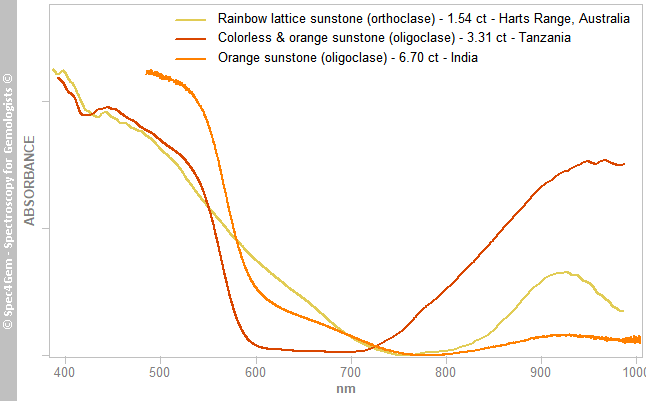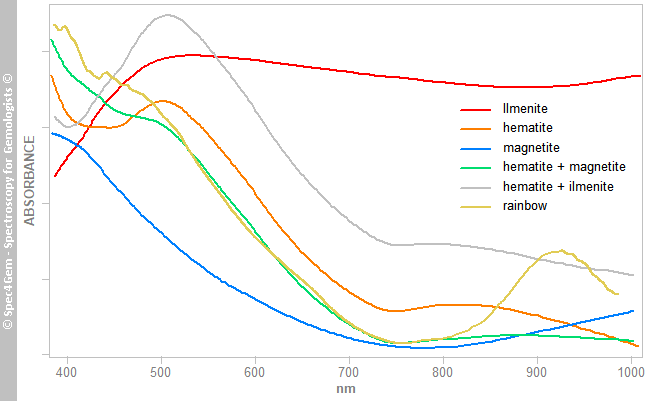The rainbow lattice sunstone, an orthoclase from Australia
- Details
- Created: Sunday, 18 February 2018 21:45
Sunstone is well known by gemologists, especially the orange varieties from India and Tanzania, another source is Oregon in USA that produces a red sunstone. The sunstone is an aventurescent feldspar usually an oligoclase / labradorite (plagioclase: Ca:Na-feldspar) and more rarely an orthoclase (k-feldspar). The aventurescence effect is caused by numerous inclusions reflecting light, whose the size greatly varies depending on sunstone type/origin. Oregon sunstone hosts microscopic copper inclusions, Tanzanian ones have rather large hematite inclusions and Indian ones show a large range of inclusions sizes.
The particular sunstone (figure 1) originating from the Harts Range mountains in central Australia (Red Center) is known since 1985 but its distribution has been quite confidential. Its 'uniqueness' is its changing appearance influenced by the observator's and light's positions. As other sunstones, it mainly has an aventurescence effect which is visible in reflected light sparkling multicolors (figure 1). While observed in transmitted light, inclusions' colors varies from orange, brown to gray (figure 2). They are orange or brown if they are transparent and gray if they are opaque. The inclusions are elongated and triangular mineral platelets, all oriented according to the crystal lattice directions. They were identified as hematite and ilmenite.
It has been described in Gems & Gemology Journal from GIA in 1989[1] and in the second volume of the Photoatlas[2] where it is written to be an oligoclase, that is not true as we will see with IR reflectance spectroscopy.
Good to know, some of the stones may be stabilized with resin.
| Shape | rectangular free form |
| Size | 8.3 x 7.4 x 2.6 mm |
| Color | host material is almost colorless to light-grayish-yellow, inclusions give either an orange/brown render (figure 2) or a multicolor render (figure 1) depending on light and observer positions, orange/brown in transmitted light and multicolor in reflected light |
| Lustre | sub-vitreous |
| Weight | 1.54 ct |
| SG | 2.57 |
| RI | impossible to get a distant vision reading, reflectivity measure gives an average RI value around 1.52 with some spots around 1.54. This consistent with orthoclase, oligoclase RI are a bit higher: 1.53-1.56 |
| DR | - |
| Pleochroism | - |
| Polariscope / Conoscope | light/dark 4 times / 360°, through the conoscope the interference figures are partly observed because of the inclusions, optical character cannot easily be determined. |
| SWUV | inert |
| LWUV | inert |
| Magnetic susceptibility N52 | weak. Orthoclase, especially yellow one with iron shows weak to moderate attraction, hematite is diamagnetic, so is the host or other inclusions magnetic ? |
| Chelsea filter | inert : same color as without the chelsea filter |
Table 1. Observational and measured properties
Infrared reflectance spectroscopy:
Two IR reflectance spectra were acquired from the top of the 1.24 ct rainbow lattice sunstone and both give the same characteristic spectrum of orthoclase (K-feldspar) with the 544 cm-1 band (figure 3). Orthoclase, microcline and sanidine are quite similar but the 544 cm-1 band is in the middle of the range from 535 to 549 cm-1 identifying this K-feldspar as orthoclase.
Current IR spectrometer setup cannot be used to identify the nature of the inclusions. A confocal raman spectrometer is required to do such in depth analysis.
 Figure 3. Orthoclase characteristic IR reflectance spectrum obtained from the top of the 1.24 ct rainbow lattice sunstone.
Figure 3. Orthoclase characteristic IR reflectance spectrum obtained from the top of the 1.24 ct rainbow lattice sunstone. UV-VIS-NIR spectroscopy:
The material being almost colorless to light-grayish-yellow, one cannot expect much from the UV-Vis spectrum. On the other hand, hosted inclusions are almost transparent and shows orange, yellow and brown colors, so it could be interesting to get the spectrum to learn more about these ilmenite and hematite inclusions. The spectra (figure 4) were acquired from the middle of the stone from a circular area of about 5 mm in diameter, collecting the transmitted light from several inclusions.
 Figure 4. Polarized UV-Vis-NIR spectra of the rainbow lattice sunstone show a strong absorption in the visible range and weaker and large band around 900 nm which is polarization dependent (iron: Fe3+).
Figure 4. Polarized UV-Vis-NIR spectra of the rainbow lattice sunstone show a strong absorption in the visible range and weaker and large band around 900 nm which is polarization dependent (iron: Fe3+).In the visible range of the spectra, there is an increasing absorption towards UV starting around 750 nm with two bumps likely two absorption bands centered at 470 and 650 nm that do not seem to depend upon the polarization. In the NIR range, there is an absorption band, polarization dependent, that shifts between 870 and 940 nm. This band attributed to iron can be observed in red jasper for instance (see Caltech[3]).
The looked up literature does not quote such polarization dependency but it is possible it has not been studied yet or not published. To avoid any problem with spectrum acquiring, another spectrum (figure 5) was acquired without any polarizing filter. The band is still there around 920 nm and it is compared to the mean of the previous two polarized spectra (figure 5). Unpolarized spectrum and the mean of polarized spectra are almost identical, so it is not an absolute certainty, but the polarized spectra are correct. The orthoclase host material does not seem to impact the spectrum, Fe3+ colored (light-yellow) orthoclase shows bands around 380 and between 400 and 430 nm.
 Figure 5. Unpolarized UV-Vis-NIR spectrum of the rainbow lattice sunstone compared to the mean of the two paolarized spectra. The spectra are almost identical, that excludes most of the problems that could be induced by polarizing filter.
Figure 5. Unpolarized UV-Vis-NIR spectrum of the rainbow lattice sunstone compared to the mean of the two paolarized spectra. The spectra are almost identical, that excludes most of the problems that could be induced by polarizing filter.This rainbow lattice sunstone spectrum is compared to those of an orange sunstone from India and colorless and orange sunstone from Tanzania, both are oligoclase, in figure 6. These sunstones are known to be colored by hematite, an iron oxyde which is usually orange to red in thin section. The corresponding spectra show a descending absorption slope between 550 and 600 nm but the rainbow one does not. Below 550 nm and above 750 nm, spectra show strong similarities. The spectrum is not the result of the sole hematite but of the other inclusions as well.
 Figure 6. Comparison to the unpolarized spectra of sunstones originating from India and Tanzania known for their hematite inclusions. Note the rainbow lattice sunstone does not show the descending absorption slope between 550 and 600 nm.
Figure 6. Comparison to the unpolarized spectra of sunstones originating from India and Tanzania known for their hematite inclusions. Note the rainbow lattice sunstone does not show the descending absorption slope between 550 and 600 nm.The rainbow lattice sunstone is supposed to host ilmenite and hematite inclusions. Very few absorption spectra of ilmenite were found in literature, and most of them are the result of a Kubelka-Munk transformation of a diffuse reflectance spectrum. Such transformation gives good results with the absorption band position but less with the band intensities. The search was extended to other oxides, especially to magnetite, others like lepidocrocite, goethite, maghemite are less common. Studies from Strens & Wood (1979)[4] and Sherman & Waite (1985)[5] give ilmenite, magnetite and hematite spectra. All these ones have been reproduced in figure 7 along that of the rainbow lattice sunstone (referenced as 'rainbow').
 Figure 7. Comparison to ilmenite, hematite and magnetite spectra gathered from published studies. Two simulated spectra were computed for the following mixes: hematite+ilmenite (gray) and hematite+magnetite (green). The rainbow lattice sunstone spectrum is closer to that of the simulated mix of hematite and magnetite.
Figure 7. Comparison to ilmenite, hematite and magnetite spectra gathered from published studies. Two simulated spectra were computed for the following mixes: hematite+ilmenite (gray) and hematite+magnetite (green). The rainbow lattice sunstone spectrum is closer to that of the simulated mix of hematite and magnetite.First, ilmenite is an iron and titanium oxide that shows a constant strong absorption over the visible and near-infrared range. It is characterized by the progressive edge from 400 to 500 nm and then an almost constant absorption. Such absorption pattern mixed with hematite one would produce a spectrum similar to that simulated and shown in gray, 'hematite + ilmenite' in figure 7. It differs of that of the rainbow sunstone by its decrease of absorption towards UV.
Similarly, if hematite pattern is mixed with magnetite one, the simulated spectrum pattern is shown in green, 'hematite + magnetite'' in figure 7. This simulation is much closer to the spectrum of the rainbow sunstone.
The iron absorption band around 900 nm is not observed in reproduced spectra of the quoted studies. Some more unpolarized spectra were acquired but not published here even do not show it, so it is not decisive.
The later two simulations raise the question about of the credibility of ilmenite inclusions in the rainbow sunstone and it likely suggests the presence of hematite and magnetite, that is a possible hypothesis to be worked out.
Photoluminescence spectroscopy:
No luminescence with the 254, 280, 377, 405, 532 and 678 nm excitation sources.
Conclusion:
The rainbow lattice sunstone is an orthoclase showing aventurescence caused by metallic inclusions. From the beginning (end of 80's) these inclusions have been believed to be hematite and ilmenite, two iron oxides (iron and titanium oxide for ilmenite). The UV-Vis-NIR spectroscopy of the sample has shown the following points:
- hematite is present,
- ilmenite is very probably missing, otherwise the absorption would have been almost high and constant over the Vis-NIR range,
- magnetite is possibly present because the simulated spectrum of combined hematite and magnetite is very close to that acquired from the sample.
This is not proving anything, but this raises the question about the presence or not of ilmenite inclusions in these Australian sunstones. The weak magnetic attraction also raises another question, does it result of iron in orthoclase or of another included material ? The presence of magnetite would cause such magnetic behavior.
Confocal raman spectroscopy could be used to identify the inclusions through the orthoclase host material.
April 2018, update following the publication of the article "Revisiting Rainbow Lattice Sunstone from the Harts Range, Australia" in the Journal of Gemmology [7]:
- SEM-EDS analysis and raman spectroscopy have definitely excluded the presence of ilmenite inclusions and identified magnetite and hematite inclusions.
- SEM-EDS analysis detects none or very few iron in the orthoclase
So, the foreseen magnetite inclusions are confirmed by the study cited above and the magnetic attraction is related to the presence of these magnetite inclusions.
[1] A beautiful new form of orthoclase, Gems & Gemmology, 1989, Spring, p. 47
[2] Photoatlas of inclusions in gemstones Volume 2, E. J. Gübelin, J. I. Koivula, Opinio Publishers, 2005, ISBN: 3-039999-029-2, pp. 413-415
[3] Quartz Visible Spectra (Red jasper) - List of Visible Data Files on the Caltech Mineral Spectroscopy Server
[4] Diffuse reflectance spectra and optical properties of some iron and titanium oxides and oxyhydroxides, R. G. J. Strens, B. J. Wood, Mineralogical Magazine, September 1979, Vol. 43, pp. 347-354
[5] Electronic Spectra of Fe3+ oxides and oxide hydroxides in the near IR to near UV, D. M. Sherman, T. D. Waite, American Mineralogist, Volume 70, 1985, pp. 1262-1269
[6] A scalable colloidal approach to prepare hematite films for efficient solar water splitting, Physical Chemistry Chemical Physics, 2013, 15, 12314
[7] Revisiting Rainbow Lattice Sunstone from the Harts Range, Australia, J. Liu, A. H. Shen, Z. Zhang, C. Wang, T. Shao, Journal of Gemmology, 2018, volume 36, No.1, pp. 44–52



